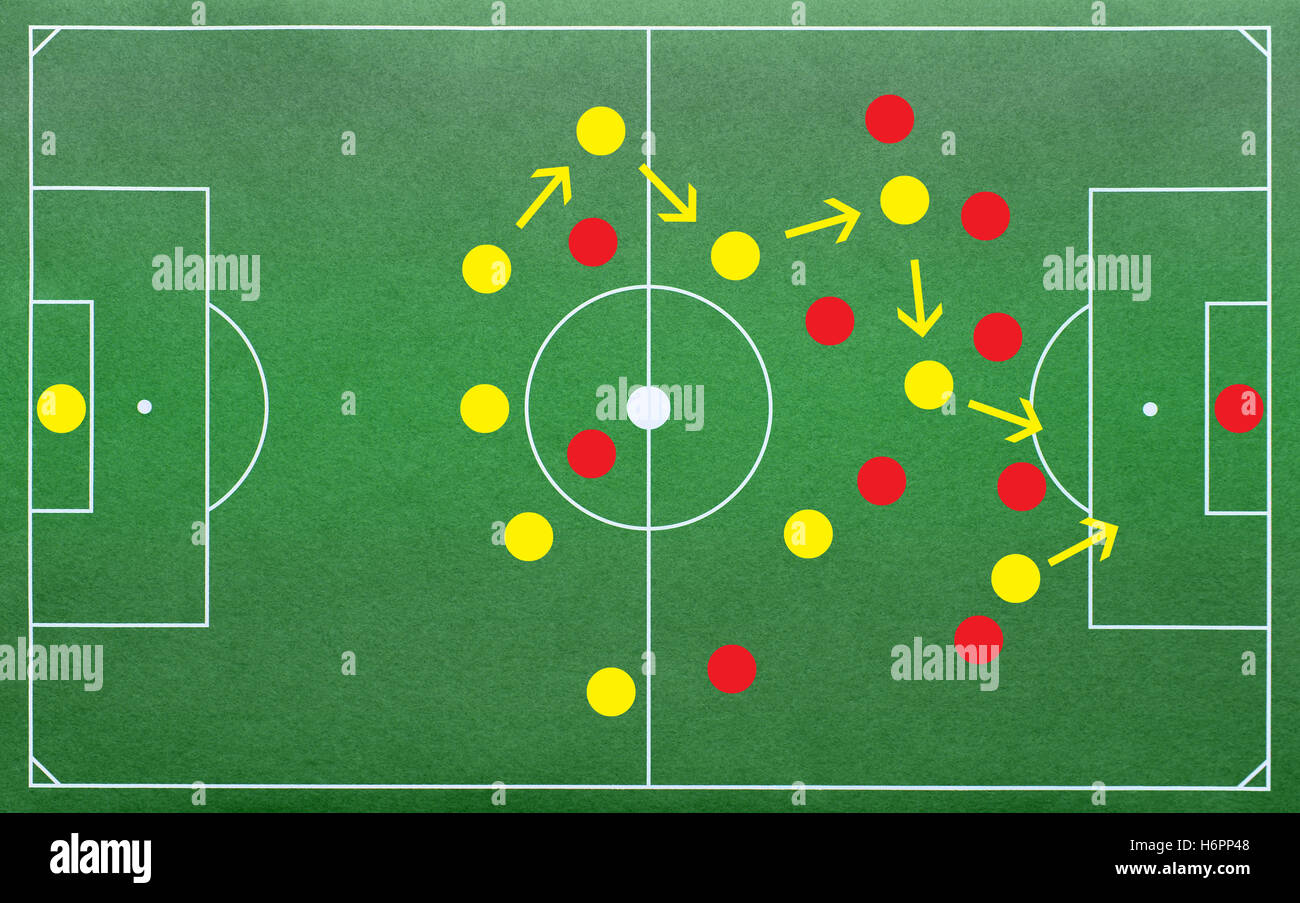Beyond the Scoreline: A Comprehensive Guide to Creating Football Tactical Statistics
Football, the beautiful game, has long been a realm of intuition, passion, and artistic flair. Yet, in the modern era, the beautiful game is increasingly becoming a data-driven science. Coaches, analysts, and even fans are moving beyond mere scorelines and basic possession stats, seeking deeper insights into how a team plays, why they succeed or fail, and what tactical patterns emerge from their performances. This quest leads to the fascinating field of creating football tactical statistics – a discipline that transforms raw event and positional data into actionable knowledge.
This comprehensive guide will delve into the intricate process of building a robust tactical statistics framework, covering data acquisition, defining key metrics, analysis methodologies, and the art of transforming numbers into tactical wisdom.
The Foundation: Understanding Data Types
Before diving into stat creation, it’s crucial to understand the fundamental types of data available in football:
-
Event Data: This is the most common and accessible form of data. It records specific actions that occur on the pitch, along with their location (X, Y coordinates), time, and outcome.
- Examples: Passes (successful/unsuccessful, type, recipient), shots (on/off target, blocked, goal), tackles (won/lost), interceptions, clearances, dribbles, fouls, saves, corners, free kicks.
- Tactical Relevance: Event data allows us to quantify individual actions and build sequences, forming the basis for many tactical metrics.
-
Positional Data (Tracking Data): This is more complex and typically requires advanced technology. It records the real-time X, Y coordinates of every player on the pitch (and often the ball) at very high frequencies (e.g., 10-25 times per second).
- Examples: Player average positions, distances covered, sprint speeds, defensive line height, team compactness, passing lanes, off-the-ball movements.
- Tactical Relevance: Positional data provides invaluable context to event data, revealing team shape, defensive structure, pressing intensity, and attacking movements that are not apparent from individual actions alone.
-
Contextual Data: While not directly statistical, this information is vital for meaningful analysis.
- Examples: Match score, opposition strength, playing surface, weather conditions, player roles, formation, injuries, game state (e.g., leading/trailing).
- Tactical Relevance: Without context, statistics can be misleading. A low possession percentage might be a deliberate tactical choice against a strong opponent, not a sign of poor performance.
Methodologies for Data Acquisition
The depth and accuracy of your tactical stats heavily depend on how you acquire the data:
-
Manual Tagging (Human Observation):
- Process: An analyst watches video footage and manually logs every event using specialized software (e.g., Dartfish, LongoMatch, custom spreadsheets). For positional data, this is impractical.
- Pros: Highly customizable (you define what to tag), relatively inexpensive for basic setups, allows for nuanced qualitative observations.
- Cons: Extremely time-consuming, prone to human error and subjectivity, difficult to scale for large datasets, limited to event data.
- Best for: Small-scale, in-depth analysis of specific games or short sequences, or for clubs with limited budgets starting their analysis journey.
-
Semi-Automated Systems (Video Analysis Software):
- Process: Software assists in tagging by providing tools like automated event detection, drawing tools for spatial analysis, and integration with databases. Some systems might offer basic player tracking from video.
- Pros: Faster than purely manual, better organization of data, some degree of spatial analysis.
- Cons: Still requires significant human input, often lacks true high-frequency positional data.
- Best for: Professional clubs with dedicated analysis teams, providing a good balance between customization and efficiency.
-
Fully Automated Systems (Optical Tracking & AI):
- Process: Cameras positioned around the stadium track player and ball movement automatically, generating high-frequency positional data. AI algorithms then process this data to identify events (e.g., a sudden change in ball velocity for a pass, player proximity for a tackle).
- Pros: Extremely accurate and high-volume data, minimal human error, provides both event and detailed positional data, scalable.
- Cons: Very expensive, requires specialized infrastructure (stadium cameras), data ownership can be an issue (often provided by third-party companies like Opta, Stats Perform, Catapult).
- Best for: Elite professional clubs, national teams, and major media outlets that require the most comprehensive and objective data.
Defining Key Tactical Metrics: Beyond the Basics
This is where the magic happens – transforming raw data into meaningful tactical insights. We’ll categorize metrics by the phase of play they primarily describe:
A. Possession & Ball Progression
- Possession Percentage (Contextualized): Not just the raw number, but where possession is held (defensive third, midfield, attacking third) and how it’s used (e.g., sterile possession vs. progressive possession).
- Pass Networks/Flow Maps: Visual representations of who passes to whom, how frequently, and in which areas of the pitch. Reveals central hubs, isolated players, and preferred passing triangles.
- Metrics: Node strength (number of passes by a player), edge weight (number of passes between two players), average pass length.
- Progressive Passes & Carries: Passes or carries that move the ball significantly closer to the opponent’s goal. Quantifies a team’s intent and ability to break lines.
- Metrics: Number of progressive passes/carries, total progressive distance, progressive passes into the final third/penalty area.
- Build-Up Patterns: Analyzing the initial phase of attacks from the defensive third.
- Metrics: Percentage of build-up from short passes vs. long balls, preferred side of build-up, involvement of specific players (e.g., deep-lying playmakers, full-backs).
- Passing Efficiency & Direction:
- Metrics: Completion rate by zone, forward pass percentage, backward pass percentage, lateral pass percentage.
- Tactical Insight: High forward pass percentage indicates direct play; high lateral/backward indicates patient build-up or recycling possession.
B. Pressing & Defensive Engagement
- PPDA (Passes Per Defensive Action): The number of passes an opponent completes in their own defensive and middle thirds before a defensive action (tackle, interception, foul) by your team.
- Tactical Insight: A low PPDA indicates an aggressive, high-pressing team; a high PPDA suggests a more passive, low-block defensive strategy.
- High Turnovers / High Press Regains: Ball recoveries made in the opponent’s attacking third.
- Metrics: Number of high turnovers, resulting shots/goals from high turnovers.
- Tactical Insight: Measures the effectiveness of a team’s high press in creating immediate goal-scoring opportunities.
- Defensive Line Height & Compactness: (Requires positional data)
- Metrics: Average distance of the defensive line from their own goal, average distance between the furthest forward and furthest backward player (length), average width of the team in defense.
- Tactical Insight: Reveals whether a team plays a high or deep line, and how well they maintain their defensive shape horizontally and vertically.
- Tackles & Interceptions by Zone: Mapping where defensive actions occur.
- Metrics: Number of tackles/interceptions in the defensive third, midfield third, attacking third.
- Tactical Insight: Indicates where a team prefers to win the ball back – deep in their own half, in midfield, or higher up the pitch.
- Opponent Touches in Penalty Box:
- Metrics: Number of opponent touches in own penalty box, number of opponent shots from inside penalty box.
- Tactical Insight: Measures how effective a team is at preventing the opposition from entering dangerous areas.
C. Attacking Patterns & Chance Creation
- Shot Locations & Expected Goals (xG):
- Metrics: Shot map, xG per shot, total xG, xG per 90 minutes.
- Tactical Insight: xG evaluates the quality of chances created, regardless of whether they result in a goal. A high xG with low goals scored suggests poor finishing; low xG with high goals suggests overperformance or luck.
- Attacking Third Entries & Penalty Box Touches:
- Metrics: Number of entries into the final third (by pass, carry, cross), number of touches inside the opponent’s penalty box.
- Tactical Insight: Quantifies a team’s ability to penetrate dangerous areas.
- Crosses (Quantity & Quality):
- Metrics: Number of crosses, successful cross percentage, cross origin (wide, deep, cut-back), resulting shots/goals from crosses.
- Tactical Insight: Reveals a team’s reliance on wide play and the effectiveness of their crossing strategy.
- Through Balls & Key Passes: Passes that directly lead to a shot.
- Metrics: Number of through balls, successful through ball percentage, number of key passes.
- Tactical Insight: Identifies creative players and patterns of direct attacking play.
- Off-Ball Movement (Requires positional data):
- Metrics: Number of runs into space, runs behind the defense, creation of passing lanes.
- Tactical Insight: Reveals how players create space for themselves and teammates, crucial for unlocking defenses.
D. Set Pieces
- Corner Kick & Free Kick Success Rates:
- Metrics: Shots/xG/goals per corner/free kick, success rate of specific routines (e.g., short corner, inswinging delivery).
- Tactical Insight: Highlights effective set-piece strategies and vulnerabilities.
- Player Positioning During Set Pieces: (Requires positional data)
- Metrics: Average positions of players during offensive/defensive set pieces, distances between players.
- Tactical Insight: Reveals defensive marking schemes or offensive attacking structures.
E. Player Roles & Responsibilities
- Heatmaps & Average Positions: Visualizing where players spend most of their time.
- Tactical Insight: Shows effective playing positions, areas of influence, and how players interpret their roles within the team’s system.
- Work Rate & Physical Output:
- Metrics: Total distance covered, distance covered at high speed/sprint, number of accelerations/decelerations.
- Tactical Insight: Indicates player effort, fitness levels, and ability to execute high-intensity tactical demands (e.g., pressing, box-to-box runs).
The Data Collection Process: A Step-by-Step Guide
- Define Objectives: What tactical questions are you trying to answer? (e.g., "Are we pressing effectively?", "How do opponents break our defensive line?", "Are our attacking patterns too predictable?")
- Choose Methodology & Tools: Based on your budget, resources, and objectives, select the most appropriate data acquisition method (manual, semi-automated, fully automated).
- Establish Data Dictionary: Clearly define every event and metric. What constitutes a "progressive pass"? What is the boundary for the "attacking third"? Consistency is paramount.
- Collect Data: Execute your chosen methodology. If manual, ensure multiple analysts are trained identically to minimize subjectivity. If automated, ensure data feeds are reliable.
- Data Cleaning & Structuring: Raw data is often messy. Clean errors, handle missing values, and structure the data into a usable format (e.g., CSV, SQL database) for analysis.
- Develop Metrics: Write scripts or use software to calculate your defined tactical metrics from the raw data.
From Raw Data to Tactical Insights: Analysis & Interpretation
Collecting numbers is only half the battle. The true value lies in extracting actionable insights.
- Context is King: Always interpret statistics within the game context (score, opponent, game state, injuries, weather). A high number of long passes might be a deliberate tactic against a strong pressing team, not a sign of poor passing.
- Comparative Analysis: Compare your team’s stats against:
- Opponents: Identify their strengths and weaknesses.
- League Averages: Benchmark your performance.
- Your Own Team Over Time: Track progress, identify trends, and evaluate tactical changes.
- Identify Trends & Patterns: Look for consistency or significant deviations. Are certain players always involved in key attacking sequences? Does the team struggle to defend crosses from a particular side?
- Combine Metrics: No single metric tells the whole story. Combine PPDA with high turnovers to understand pressing effectiveness. Combine xG with shot locations to assess chance quality.
- Visualise Data: Charts, graphs, heatmaps, pass networks, and dashboards make complex data understandable and highlight key insights at a glance. Tools like Tableau, Power BI, Python (Matplotlib, Seaborn), or R (ggplot2) are invaluable.
- Qualitative Validation: Always cross-reference statistical findings with video analysis. Do the numbers reflect what you see on the pitch? The video provides the "why" behind the "what."
- Actionable Recommendations: The ultimate goal is to translate insights into concrete recommendations for coaching staff and players. "Our left-back is being isolated in build-up; consider a wider position for the left winger."
Challenges and Limitations
Creating tactical statistics is not without its hurdles:
- Data Quality: Inaccurate or incomplete data can lead to flawed conclusions.
- Subjectivity (in manual tagging): Different analysts might interpret events differently.
- Contextual Nuance: Football is fluid; a statistic might not capture the full tactical intent or player decision-making.
- Cost & Resources: High-end automated systems are expensive.
- Human Element: Statistics are a tool, not a replacement for coaching expertise, player intuition, and the unpredictable nature of the game.
- Correlation vs. Causation: A correlation between two stats doesn’t necessarily mean one causes the other.
Conclusion
The creation of football tactical statistics has revolutionized how the game is understood and played. By meticulously collecting, defining, and analyzing data, clubs and analysts can move beyond anecdotal observations to develop evidence-based strategies. From understanding a team’s defensive compactness through PPDA to dissecting attacking patterns with pass networks and xG, the depth of insight available is unprecedented.
While challenges remain, the continuous advancement of data acquisition technologies and analytical methodologies ensures that the intersection of football and data will only grow richer. For those willing to embrace the numbers, the pitch becomes an open book, revealing the intricate tactical stories hidden beneath the surface of every match. The beautiful game, truly, is becoming beautifully measurable.




